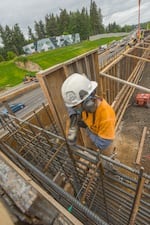A statewide effort to recruit and retain a more diverse construction workforce in Oregon is beginning to pay off, with women and people of color making up more than half of all new apprentices in construction-related jobs in 2022 and 2023. That’s according to a new report evaluating the Oregon Department of Transportation and Oregon Bureau of Labor and Industries’ Highway Construction Workforce Development Program.

Construction jobs are a historically white, male dominated field. A crew works on the Hall Boulevard overpass in Beaverton on May 23, 2024.
Courtesy of the Oregon Department of Transportation
Among other resources, the program offers career exploration classes, pre-apprenticeship training and financial assistance to people interested in jobs commonly associated with highway construction. That includes trades like ironworkers, cement masons, electricians, carpenters and laborers. The Federal Highway Administration provides the funding.
The biennial report, which has been analyzing the program since its inception in 2010, shows the most recent cohort of people entering construction jobs in the state is also the program’s most diverse.
Of the nearly 2,000 people who started apprenticeships in these fields between 2022 and 2023, 14% were women and 45% were people of color. Less than half, 46%, were white men. The latter statistic is a 20 percentage point drop from when the state first started its construction workforce diversification effort.
Construction trades are traditionally jobs occupied by white men but the industry has a lot to gain from expanding its horizons, especially as the state is experiencing a workforce shortage, said Portland State University sociology professor Maura Kelly.
“There is not an unlimited pool of white men to draw from,” said Kelly, who co-authored the report. “If we are going to have a steady pipeline of people entering the trades, we need to look at groups that have been historically excluded from these kinds of jobs. For too long, women and people of color were explicitly kept out.”

A sticker that reads "gender roles are dead" is on the helmet of a construction crew member working on new retaining wall in Tigard on May 23, 2024.
Courtesy of the Oregon Department of Transportation
The report also found that program participants who received at least one type of supportive service were 10% more likely to complete apprenticeship programs. Services included everything from money to pay for job-related expenses, like safety clothing and tools, to extra cash for child care.
Participants also had access to a hardship fund in case they experienced an unexpected financial expense during an apprenticeship, such as a broken down vehicle or a medical emergency.
Those who took advantage of both the workforce program’s financial resources and non-financial support, like budgeting classes and mentorship, had an even higher chance of completing apprenticeships.
This progress may help address retention rates among new construction workers, which is at historic lows. Most apprenticeships analyzed in the report take at least four to six years to complete.
“About half of all (people) who start an apprenticeship won’t finish it,” Kelly said. “So, in times when there are worker shortages, it’s really critical that we not only recruit people into the industry, but retain those that we already have.”
The report also highlighted that apprenticeship completion rates for women and people of color are still far behind white men. Black men in particular had the lowest chance of completing at 33%.
Kelly said these historically marginalized groups of people often face more challenges in the construction industry, like a hostile work environment. Apprentices who are women and people of color have cited jobsite harassment and discrimination as well as feelings of exclusion and isolation as reasons for leaving construction jobs.
The report recommends the statewide program continue to build its efforts to create a sense of belonging in the industry if it aims to maintain its current diverse pipeline of workers.
A recent construction market study projected a 10% increase in construction-related jobs in the Portland metropolitan area alone between 2020 and 2030, with the median wage hovering at $33 an hour.
Creating a more diverse and welcoming construction workforce should be the goal for both public and private employers, Kelly said.
“These are really great jobs that offer good pay and benefits,” she added. “(These jobs) really should be available to everybody.”
